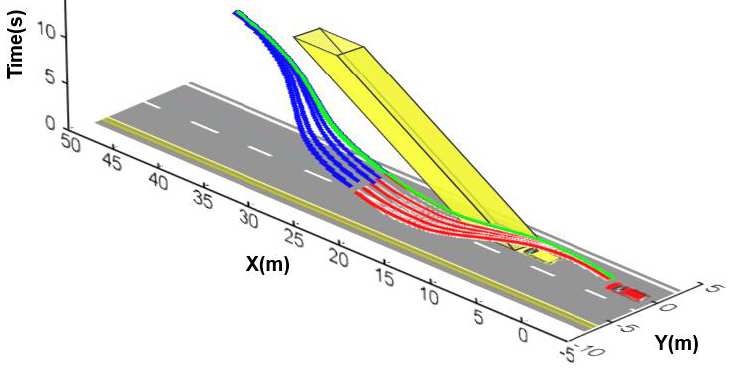Prof. Bambang Riyanto
STE-ITB
Arief Syaichu Rohman
STE-ITB
Egi Muhammad Idris Hidayat
STEI-ITB
Abstract
Autonomous vehicles must: (1) globally plan paths, (2) perceive their surroundings, (3) predict the movements of nearby objects, and (4) make actionable decisions. This research focuses on developing algorithms for environmental perception and local path planning to improve passenger safety and comfort while addressing challenges in urban environments and extreme weather.The study has two primary objectives. The first is to create an optimal local path-planning strategy that prioritizes passenger safety and comfort in dynamic urban settings. The second is to develop a robust perception system capable of detecting objects reliably in low-light and adverse weather conditions.The proposed methods include integrating the RRT-ACS algorithm, bi-directional rule templates, and a time-space configuration to improve path planning. For perception, a hybrid model combining MIRSA-based denoising with YOLOV7MOD object detection enhances reliability under challenging conditions. Results confirm the effectiveness of these approaches, showcasing improved safety, comfort, and adaptability in autonomous vehicle navigation.
Keyword: Autonomous Vehicles, Local Path Planning, Perception System, Safety, Comfort
Introduction
Autonomous vehicles (AVs) are revolutionizing the transportation industry with promises of safer roads, reduced traffic congestion, and improved passenger experiences. However, achieving seamless AV operation in urban environments presents unique challenges. Urban settings are characterized by dynamic traffic conditions, complex road structures, and unpredictable behaviors of other road users. Furthermore, adverse weather conditions, such as fog, rain, and low-light scenarios, severely impair the perception systems of AVs.
To address these challenges, this research focuses on two critical aspects:
- Local Path Planning: Ensuring AVs navigate safely and efficiently in dynamic urban scenarios by combining advanced algorithms and predictive models to handle uncertainty and maintain smooth motion
- Perception System: Enhancing object detection reliability through robust image denoising and recognition techniques to ensure AVs can perceive their surroundings accurately even in poor visibility
This research aims to integrate cutting-edge algorithms for path planning and perception to improve safety, comfort, and adaptability of AVs in real-world urban environments.
Research Method
This research employs a dual-focused approach addressing two critical aspects of autonomous vehicle systems: local path planning and perception.
- For local path planning, the RRT+BRT+CTS framework integrates three core elements. First, the RRT-ACS algorithm combines Rapidly Exploring Random Tree and Ant Colony System techniques to optimize pathfinding efficiency. Second, the integration of Bi- directional Rule Templates enables adaptive maneuvering by growing trees from both the starting and goal nodes until a connection is formed, producing smooth and collision-free Third, the inclusion of Time-Space Configuration adds temporal data to spatial planning, allowing the system to consider real-time traffic conditions and ensure safety during navigation. Figure 1 depicts the application of this framework in a dynamic urban intersection.
- For perception, the MIRSA+YOLOV7MOD framework enhances object detection under challenging weather conditions. The MIRSA module, based on a modified MIRNet-v2, effectively denoises images impacted by fog, rain, and low-light scenarios, further refined using a Gaussian Mixture Model (GMM). The YOLOV7MOD module then processes these clean images for accurate object detection, leveraging advanced convolutional architectures. The system was trained using a Low-Light and Rainy Traffic Image Dataset (LLD) to ensure its robustness in real-world scenarios. Figure 2 showcases the system’s performance in detecting objects in foggy conditions.


Disscussion & Result
The RRT+BRT+CTS framework shows improvements in local path planning while reducing computation time. The framework successfully navigates scenarios such as overtaking, lane merging, and intersections while ensuring a smooth and collision-free trajectory. This approach dynamically adapts to road conditions, making it highly effective in complex urban environments.
The MIRSA+YOLOV7MOD framework achieves robust perception under adverse weather, with PSNR of 38.27, SSIM of 0.967, and mAP scores of 0.7457, 0.8336, and 0.9145 in heavy, medium, and light fog, respectively. Figure 3 highlights its superior detection in foggy conditions.
Both systems demonstrated high performance through separate simulation tests. Future work involves integrating them and conducting real- time tests using a vehicle test bed, as shown in Figure 4.


Conclusion
The proposed frameworks effectively address key challenges in autonomous vehicle navigation. The RRT+BRT+CTS framework optimizes path planning with high efficiency and safety, while MIRSA+YOLOV7MOD enhances perception reliability in adverse weather. Together, these innovations demonstrate significant advancements in ensuring the adaptability and robustness of autonomous vehicles in complex urban environments.